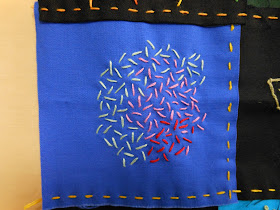I realized after several weeks that my stitch repertoire was sadly limited, and decided to find a book and look up some new stitches. So the project took on an extra dimension that I had not anticipated at the start of the year: a tutorial in embroidery. I thought I would use my progress reports to share some of the stitches I'm using.
Simplest of all is the running stitch, where the needle comes up and goes down along a line. Here's an example of a lot of parallel straight lines in running stitch:
And if you put one layer of straight stitches over another, you end up with cross stitch, everybody's childhood favorite.
They can be neat, in a regular pattern as above, or messy, piled on top of one another with no plan, as below.
I guess you could do an awful lot of embroidery using just straight stitches, without getting too bored.






I am also expanding my embroidery repertoire. If you're looking for another book resource, I can recommend Yvette Stanton's stitch dictionaries for both left handed and right handed embroidered. See
ReplyDeletehttp://www.vettycreations.com.au/books.html
Nice done.
ReplyDeleteIt is good to find another person who loves embroidery even on its simplest level. That's a compliment, not a put-down! A wonderful feeling of peace and contentment washes over when I hold a needle and thread in my hand. During a terrible back problem, embroidery was the most effective and powerful pain reliever I could find.
ReplyDeleteMartha Ginn
An excellent book which I think you will appreciate is The Stitches of Creative Embroidery, Jacqueline Enthoven, first published in 1964. Used copies are available quite inexpensively. A revised and expanded version is listed on Amazon, but I have never see it so do not know what is different since I have an original hardback. Enthoven offers much more than just a stitch dictionary.
ReplyDeleteBy the way, I did a masters in journalism in the early 1980s when I was in my late 30s-early 40s, had a family, and wanted to change careers. I had your dad for a prerequisite course. He was delightful, despite my being an "elderly" student, and I still have one of his books that he signed for me.
thanks for both the book suggestions. I think I have consulted the Enthoven book in the past, although I don't own it. I must say that although I'm dutifully trying new stitches, most of them aren't striking much of a chord. I think I'm happier playing around with the old familiar stitches and seeing what can happen if you stretch the bounds. I'll think about this and write about it some time....
ReplyDeletePRK -- this is funny! Before I retired from my communication career I ran into people all the time who knew my father, either from his teaching or his consulting work. But you're the first one I've met in my art career who ever heard of him! I take it you were at VCU?
ReplyDeleteYes, I was at VCU, meant to say that. If I recall correctly, your dad used to call that his "retirement" job. I used to tease him that he had fixed it so that I couldn't read anymore until I knew what typeface I was staring at. And I dreamt about type that year!
ReplyDeleteI retired a few years ago from paid writing and editing, though I do still write, dusted off my sewing machine and knitting needles, and realized some old skills are quite enjoyable now that I have time. In theory I was going to make a quilt for new twin grandkids with the help of a quilter friend; instead I found I really liked designing and making small quilts as art. I have not been at all interested in using patterns or making traditional quilts, have tried various techniques, and mainly do improvisational piecing with segments and pieces scattered on the floor until they come together.